Fast
Fourier Transform (FFT)
In this section we present several methods for computing the DFT efficiently. In view of the importance of the DFT in various digital signal processing applications, such as linear filtering, correlation analysis, and spectrum analysis, its efficient computation is a topic that has received considerable attention by many mathematicians, engineers, and applied scientists.
From this point, we change the notation that X(k), instead of y(k) in previous sections, represents the Fourier coefficients of x(n).
Basically, the computational problem for the DFT is to compute the sequence {X(k)} of N complex-valued numbers given another sequence of data {x(n)} of length N, according to the formula

We observe that for each value of k, direct computation of X(k) involves N complex multiplications (4N real multiplications) and N-1 complex additions (4N-2 real additions). Consequently, to compute all N values of the DFT requires N 2 complex multiplications and N 2-N complex additions.
Direct computation of the DFT is basically inefficient primarily because it does not exploit the symmetry and periodicity properties of the phase factor WN. In particular, these two properties are :

Radix-2 FFT Algorithms
Let us consider the computation of the N = 2v point DFT by the divide-and conquer approach. We split the N-point data sequence into two N/2-point data sequences f1(n) and f2(n), corresponding to the even-numbered and odd-numbered samples of x(n), respectively, that is,

Now the N-point DFT can be expressed in terms of the DFT's of the decimated sequences as follows:


Since F1(k) and F2(k) are periodic, with period N/2, we have F1(k+N/2) = F1(k) and F2(k+N/2) = F2(k). In addition, the factor WNk+N/2 = -WNk. Hence the equation may be expressed as


Figure
TC.3.1 First step in the decimation-in-time algorithm.
By computing N/4-point DFTs, we would obtain the N/2-point DFTs F1(k) and F2(k) from the relations

For illustrative purposes, Figure TC.3.2 depicts the computation of N = 8 point DFT. We observe that the computation is performed in tree stages, beginning with the computations of four two-point DFTs, then two four-point DFTs, and finally, one eight-point DFT. The combination for the smaller DFTs to form the larger DFT is illustrated in Figure TC.3.3 for N = 8.

Figure
TC.3.2 Three stages in the computation of an N
= 8-point DFT.

Figure
TC.3.3 Eight-point decimation-in-time FFT algorithm.

Figure
TC.3.4 Basic butterfly computation in the
decimation-in-time FFT algorithm.
An important observation is concerned with the order of the input data sequence after it is decimated (v-1) times. For example, if we consider the case where N = 8, we know that the first decimation yeilds the sequence x(0), x(2), x(4), x(6), x(1), x(3), x(5), x(7), and the second decimation results in the sequence x(0), x(4), x(2), x(6), x(1), x(5), x(3), x(7). This shuffling of the input data sequence has a well-defined order as can be ascertained from observing Figure TC.3.5, which illustrates the decimation of the eight-point sequence.

Figure
TC.3.5 Shuffling of the data and bit reversal.
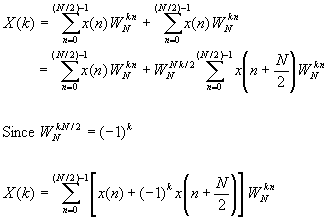

The computational procedure above can be repeated through decimation of the N/2-point DFTs X(2k) and X(2k+1). The entire process involves v = log2N stages of decimation, where each stage involves N/2 butterflies of the type shown in Figure TC.3.7. Consequently, the computation of the N-point DFT via the decimation-in-frequency FFT requires (N/2)log2N complex multiplications and Nlog2N complex additions, just as in the decimation-in-time algorithm. For illustrative purposes, the eight-point decimation-in-frequency algorithm is given in Figure TC.3.8.

Figure
TC.3.6 First stage of the decimation-in-frequency FFT
algorithm.

Figure
TC.3.7 Basic butterfly computation in the
decimation-in-frequency.

Figure
TC.3.8 N = 8-piont decimation-in-frequency FFT
algorithm.
We observe from Figure TC.3.8 that the input data x(n) occurs in natural order, but the output DFT occurs in bit-reversed order. We also note that the computations are performed in place. However, it is possible to reconfigure the decimation-in-frequency algorithm so that the input sequence occurs in bit-reversed order while the output DFT occurs in normal order. Furthermore, if we abandon the requirement that the computations be done in place, it is also possible to have both the input data and the output DFT in normal order.
Radix-4 FFT Algorithm
When the number of data points N in the DFT is a power of 4 (i.e., N = 4v), we can, of course, always use a radix-2 algorithm for the computation. However, for this case, it is more efficient computationally to employ a radix-r FFT algorithm.
Let us begin by describing a radix-4 decimation-in-time FFT algorithm briefly. We split or decimate the N-point input sequence into four subsequences, x(4n), x(4n+1), x(4n+2), x(4n+3), n = 0, 1, ... , N/4-1.


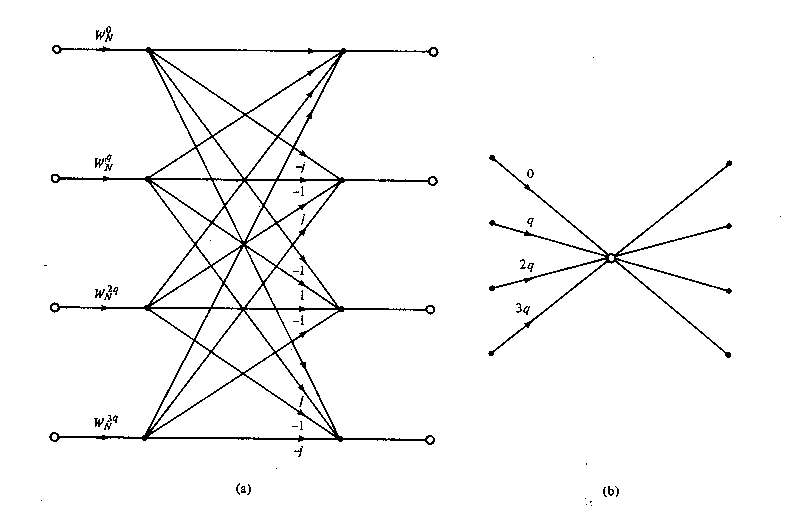
Figure
TC.3.9 Basic butterfly computation in a radix-4 FFT
algorithm.

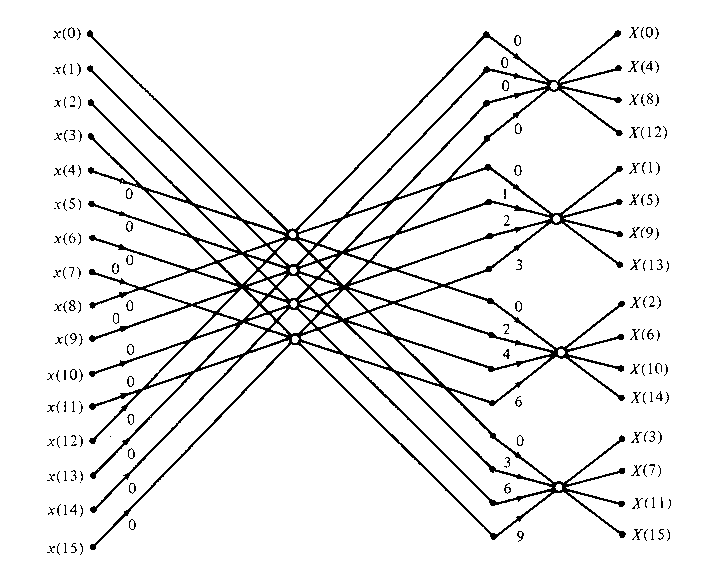
Figure
TC.3.10 Sixteen-point radix-4 decimation-in-time
algorithm with input in normal order and output in digit-reversed
order
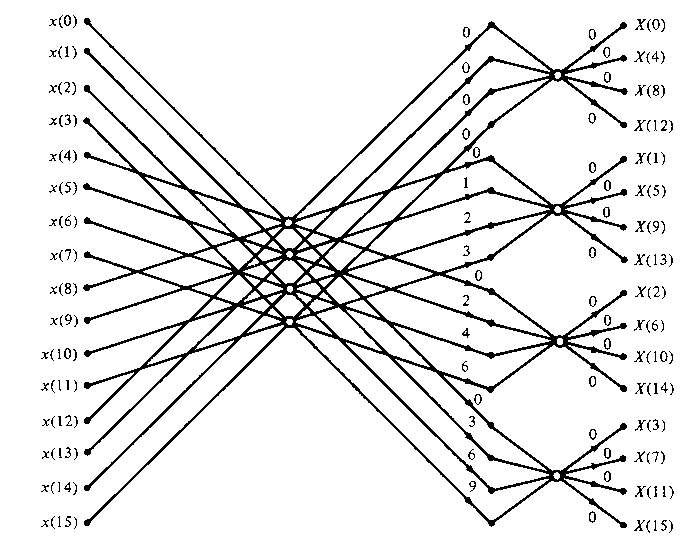
Figure
TC.3.11 Sixteen-point, radix-4 decimation-in-frequency
algorithm with input in normal order and output in digit-reversed
order.
For illustrative purposes, let us re-derive the radix-4 decimation-in-frequency algorithm by breaking the N-point DFT formula into four smaller DFTs. We have
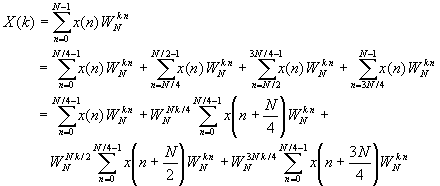

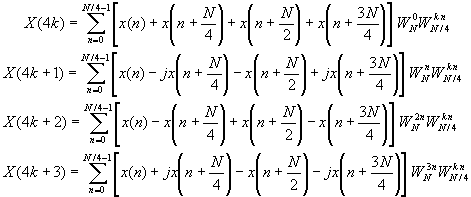
Split-Radix FFT Algorithms
An inspection of the radix-2 decimation-in-frequency flowgraph shown in Figure TC.3.8 indicates that the even-numbered pints of the DFT can be computed independently of the odd-numbered points. This suggests teh possibility of using different computational methods for independent parts of the algorithm, with the objective of reducing the number of computations. The split-radix FFT (SRFFT) algorithms exploit this idea by using both a radix-2 and a radix-4 decomposition in the same FFT algorithm.
First, we recall that in the radix-2 decimation-in-frequency FFT algorithm, the even-numbered samples of the N-point DFT are given as
The odd-numbered samples {X(2k+1)} of the DFT require the pre-multiplication of the input sequence with the twiddle factors WNn. For these samples a radix-4 decomposition produces some computational efficiency because the four-point DFT has the largest multiplication-free butterfly. Indeed, it can be shown that using a radix greater than 4 does not result in a significant reduction in computational complexity.
If we use a radix-4 decimation-in-frequency FFT algorithm for the odd-numbered samples of the N-point DFT, we obtain the following N/4-point DFTs:

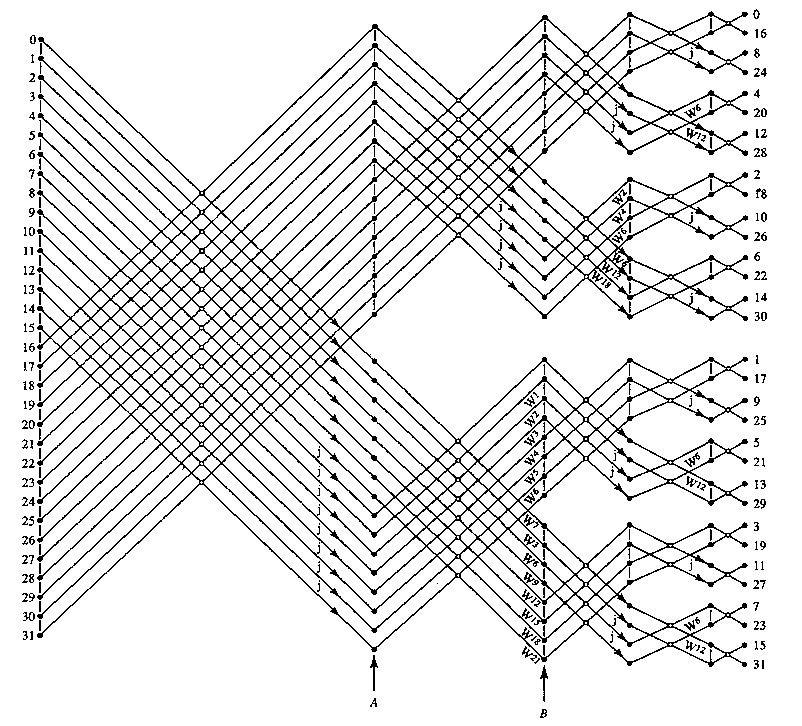
Figure
TC.3.12 Length 23 split-radix FFT algorithms from paper
by Duhamel (1986); reprinted with permission from the IEEE
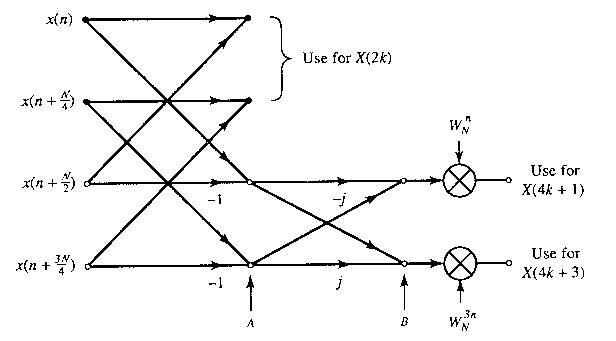
Figure
TC.3.13 Butterfly for SRFFT algorithm.
| Real Multiplications | Real Additions | |||||||
| N | Radix-2 | Radix-4 | Radix-8 | Split Radix | Radix-2 | Radix-4 | Radix-8 | Split Radix |
| 16 | 24 | 20 | 20 | 152 | 148 | 148 | ||
| 32 | 88 | 68 | 408 | 388 | ||||
| 64 | 264 | 208 | 204 | 196 | 1032 | 976 | 972 | 964 |
| 128 | 72 | 516 | 2054 | 2308 | ||||
| 256 | 1800 | 1392 | 1284 | 5896 | 5488 | 5380 | ||
| 512 | 4360 | 3204 | 3076 | 13566 | 12420 | 12292 | ||
| 1024 | 10248 | 7856 | 7172 | 30728 | 28336 | 27652 | ||
Table
TC.3.1 Number of Nontrivial Real Multiplcations and
Additions to Compute an N-point Complex DFT
No hay comentarios:
Publicar un comentario